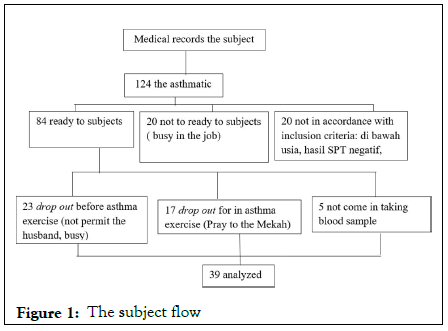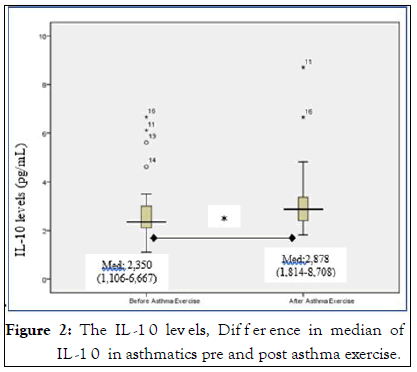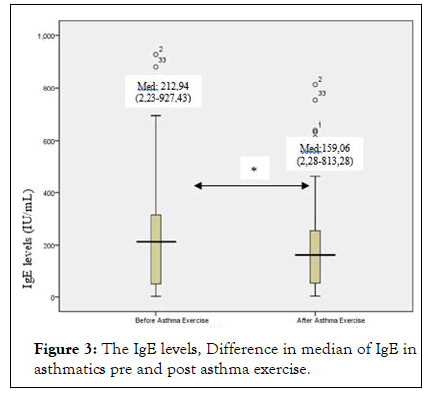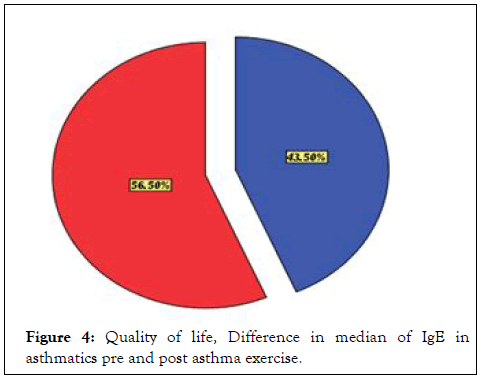Journal of Pharmaceutical Care & Health Systems
Open Access
ISSN: 2376-0419
ISSN: 2376-0419
Research Article - (2022)Volume 9, Issue 1
Background: Asthma is a chronic inflammation of the respiratory tract involves the interaction of several cell types and mediators that will cause asthma symptoms. This study aims to study the effect of asthma exercise on interleukin, immunoglobulin and quality of life in autopsy asthmatic persistent.
Methods: This research is an experimental study with pre-post-test group design. 39 subjects were taken based on medical records at Prof. Dr. Margono Soekarjo Regional Public Hospital of Purwokerto with inclusion criteria. Interleukin 10 (taken from peripheral blood mononuclear cell with supernatant) and immunoglobulin E (blood plasma) test were done by ELISA. Quality of Life parameter used Asthma Quality of Life Questionnaire (AQLQ). All parameters were tested before and after doing asthma exercise for 4 times per week in 8 weeks with duration of 60 minutes. The analysis used was Wilcoxon and spearman analysis.
Results: There was a significant effect before and after asthma exercise increasing interleukin 10 with p value: 0.000; decrease immunoglobulin E with p value:0.001 and quality of life with p value:0,000. There was no correlation between the increase of interleukin 10 and the quality of life with p value: 0.063; no correlation increase interleukin 10 and decrease immunoglobulin E with p value: 0.280; no correlation between decrease immunoglobulin E and quality of life with p value 0.206.
Conclusion: Asthma exercise can increase interleukin 10 and quality of life and decrease immunoglobulin E levels. However, there was no correlation between the increase levels of interleukin 10, decrease immunoglobulin E and increase quality of life.
Asthma exercise; Interleukin 10; Immunoglobulin E; Quality of life
Asthma is a chronic inflammation of the respiratory tract with symptoms of wheezing, shortness of breath, chest tightness and cough accompanied by limited expiration. Asthma population reaches 1-18% in the world and is associated with the occurrence of hyper responsive respiratory tract which is stimulated both directly and indirectly resulting in chronic inflammation in the respiratory tract so as to interfere with productivity and quality of life [1,2]. Social and economic factors are necessary for understanding asthma and its care, whether viewed from the perspective of the individual sufferer or the health care delivery system. The number of disability-adjusted life years lost due to asthma worldwide is similar to that for diabetes, liver cirrhosis and schizophrenia [3]. Interleukin-10 or cytokine synthesis inhibitory factor has important anti-inflammatory activities in immune diseases and an intrinsic anti-inflammatory peptide, originally identified and cloned as cytokine synthesis inhibitory factor, which has major down regulatory influences on inflammation. Interleukin-10 is a cytokine that has a role in reducing the inflammatory process that is regulated by Th2 and also has a beneficial effect in improving the structure of the respiratory tract, but the effect of IL-10 on the airway response is still contradictory. One study showed that IL-10 decreases airway response, but other studies have found that IL-10 increases allergen-induced airway responses despite decreased eosinophil intake [4]. The activation of Th2 and B lymphocytes underlies the process of sensitization to allergens in genetically predisposed individuals. Antigens processed by Antigen- Presenting Cells (APCs) can be recognized by Th2 cells. Interleukins released by activated Th2 cells (e.g., IL-4 and IL-13) enhance production of IgE antibodies [5]. The effect of physical exercise on IgE in asthma patients is still controversial. The asthma Quality of Life Questionnaire (AQLQ) was developed to measure the function problems (physical, emotional, social and occupational) that are most troublesome to adults (17-70 years) with asthma [6,7]. This study aims to analyze the effect of asthma exercise on IL-10, IgE, and the quality of life of asthma patients.
This study is an experimental study with the pre and posttest design. The patients were recruited by on the medical records at Prof. Dr. Margono Soekarjo Hospital, Purwokerto, Indonesia. The diagnosis of asthma was established according to the global initiative for asthma 2017. The inclusion criteria were patients aged 19-67 years, atopic asthma with classification mild-tomoderate persistent, no worm eggs found in feces, having a good-medium fitness level (6-min fitness test run), and showing positive skin prick test on house dust mite allergens such as dermatophagoides pteronyssinus, dermatophagoides farinae, and blomia tropicalis, committed to follow asthma exercise at least 24 times (80% of the total number of asthma exercise) [8]. IL-10 secreted by peripheral blood mononuclear cell taken from supernant and IgE in the plasma was measured by the enzymelinked immunosorbent assay (Cat. Number:D1000B R and D Systems, Inc Canada) and IgE was taken from blood plasma (Cat Number:EV38409601E Euroimmun AG, Germany). All parameters were tested before and after asthma exercise.
The sample size formula
n=(zα+zβ)2/π(p1-p2)2
π=(P1Q2)+(P2Q1); α:5% ;Zα:1,96; β:20%; Zβ:0.84.
p1=Quality of life proportion before asthma exercise based on references: 0.35.
Q1=1-P1= 1-0.35=0.65.
P1-P2=Minimal difference quality of life was significant between before and after astma exercise 0.35.
P2=Quality of life proportion after asthma exercise based on references=0.35+0.35=0.7 based on that count obtained the sample minimal was 36 the subjects (Figure 1).

Figure 1: The subject flow
Asthma exercise
Asthma exercise 4 times a week (Sunday, Wednesday, Friday and Saturday) during 8 weeks with a duration of 60 min divided two class, outdoor class at 6 am and indoor class at 2 pm. Asthma exercise consist of a few step of movement, there were warm up, stretching, core exercise 1, core exercise 2, aerobic 1, aerobic 2, aerobic 3 and cooling down. The subjects were not forced to do aerobic 3 because to stable cardiorespiratory the subjects. The reason divided 2 classes is because to adjust the time of research subjects who have to work and do other activities. This division of time and class has become the agreement of the research subjects and the trainer. The intensity is based on the subject's maximum pulse using the HR (Heart Rate) formula max: 80% x (220-40). Asthma exercise which is a type of aerobic exercise in this study used a training zone in the medium intensity of 50%-70% of HR max with the HR target formula:(HR max (220-age)-HR breaks) x intensity+HR rest. The pulse count is done before warming up, after core B and aerobic exercise
Quality of life
They were assessed for HRQoL using Asthma Quality of Life Questionnaire (AQLQ). Each participant completed the selfadministered questionnaire. The Asthma HRQo questionnaire is a disease-specific 32-item instrument, including 4 domains: symptoms, emotions, exposure to environmental stimuli and activity limitations. Subjects rated the impairments they have experienced during the previous 14 days and responded to each item on 7-point scales. The scoring was done by dividing the 32 items in questionnaire into 4 domains where items: 1-5, 11, 19, 25, 28, 31, 32 was included under Activity limitation domain. Items: 6, 8, 10, 12, 14, 16, 18, 20, 22, 24, 29, 30 was included for calculating symptoms domain. For emotional function domain items 7, 13, 15, 21 and 27 was included. The Environmental stimuli domain was calculated using items 9, 17, 23 and 26. Individual items were equally weighted and mean AQLQ(S) score was obtained by adding all 32 responses and dividing it by 32. The scores for 4 domains were analyzed by adding the response of each of items in the domain and dividing by number of items in particular domain. Thus, the overall scores and domain scores range from 1 to 7 with higher scores indicating better quality of life. Score of 7 by the patient was considered has no impairments due to their asthma and score 1 at the other end of the range was severe impairments. The score 4 in the middle of the range indicated moderate degree of impairment. Thus the degree of impairments the patient was experiencing due to their asthma was evaluated by the scoring and as score drops below 7 the level of impairment and thus quality of life was interpreted. The original English version of the asthma quality of life questionnaire of the questionnaire was translated into Indonesian language direct by E. Juniper from Canada as creator this questionnaire [9-11].
Statistical analysis
The obtained data were subjected to statistical analysis using the Statistic Package for the Social Sciences (SPSS) version 19 (IBM Corp, Armonk, NY, USA). Normality of data distribution was determined by the Kolmogorov–Smirnov test. Non-normal data distribution was presented as median (minimal–maximal). The Wilcoxon test was used to analyze the influence before and after asthma exercise, whereas Pearson test was used to analyze the correlation between numerical variables. P<0.05 was considered to be statistically significant (Figures 2-4 and Table 1).

Figure 2: The IL-10 levels, Difference in median of IL-10 in asthmatics pre and post asthma exercise.

Figure 3: The IgE levels, Difference in median of IgE in asthmatics pre and post asthma exercise.

Figure 4: Quality of life, Difference in median of IgE in asthmatics pre and post asthma exercise.
Based on Figure 2 shows there is an increase in IL-10 before and after asthma exercise with a median value before asthma exercise 2.350 and after asthma exercise 2.878. Interleukin-10 is a cytokine to regulate immune function that suppresses the immune response through pleiotropic effects (antioxidant effects, anti-inflammatory effects, inhibition of cell proliferation, ant cariogenic effects, anticoagulant effects, and action). This study is in accordance with study that exercise can improve IL-10. Interleukin-10 increases longer in endurance training such as marathons compared to short duration exercises. Cytokin responses are not significant occurring during and after intensive short-duration training and eccentric contraction exercises. Responses do not depend on exercises that cause damage to muscles but are related to the intensity of the exercise (psychological stress / burden). The parameters of the immune system vary greatly depending on age, physical activity and emerging diseases. The mechanism of inflammation in asthma is very complex which can increase the response to inflammation in the airways. The results of this study are not in accordance with the research conducted by Yalcin that there was no influence between before and after physical exercise by walking for 12 weeks with duration of 30 minutes for 4 times a week. Differences in the results of this study with Yacin can be caused by 30 minutes walking exercise is a low intensity physical exercise. Based on the theory of low intensity with 40% has not been able to stimulate anti-inflammatory secretion IL-10. Based on the theory it is said that the physical exercise program recommended for asthma is aerobic physical exercise with a minimum of 5 times a week with a duration of at least 30 minutes, while research conducted by Yacin is done 4 times a week with a duration of 30 minutes so it has not been able to stimulate anti-inflammatory secretions [2,3]. The results showed a significant influence with p: 0,000 before and after asthma exercise. This is also consistent with the Lowder study, that there was an increase in IL-10 T-regulator in mice stimulated by ovalbumin using moderate intensity exercise [3]. Changes in cytokines during physical exercise are expected to improve metabolism, tissue remodeling and response to inflammation. Results showed that there were 4 subjects who had IL-10 levels after asthma exercise dropped, 34 subjects went up and 1 participant showed IL-10 levels remained before and after asthma exercise (Data not showed). Based on studies conducted by Giron in Benini various factors that influence IL-10 secretion are gender. Women have greater release of Th2 cytokines (IL-10) than men. This is due to the presence of estrogen and progesterone hormones which induce IL-10 production. The use of oral contraceptives can affect IL-10 levels at the baseline. The physiological response to muscle damage is inflammation that triggers cytokine production, while in asthma patients it depends on the severity of inflammation [5-6]. The results showed a significant influence with p:0.000 before and after asthma exercise. This is also consistent with the Lowder study, that there was an increase in IL-10 T-regulator in mice stimulated by ovalbumin using moderate intensity exercise.
Based on Figure 3 it was found that IgE levels before and after asthma exercise p:0.001 with IgE levels after asthma exercise was lower than before asthma exercise there were 29 subjects, and 10 subjects (Data not showed). IgE levels after asthma exercise were higher than before asthma exercise. According to research, moderate intensity exercise with 60% VO2 max for 40 minutes can reduce IgE in subjects who experience allergies and do not change IgE levels in subjects who do not experience allergies [7]. IgE plays a role in limiting activation of mast cells and basophils that release mediators that trigger the acute phase of allergies and the appearance of acute symptoms [8]. Acute phase reactions occur several minutes after exposure and are followed by a slow phase which causes the patient to be sensitized so that inflammation occurs. Slow phase reactions trigger the production of several mediators, cytokines and chemokines activated by mast cells and basophils. The role of IgE influences cell activity involving specific receptors namely high-affinity (FcεRI) and low-affinity CD23 (or FcεRII) receptors. FcεRI receptors aside from being expressed by mast cells and basophils but also by dendritic cells, respiratory tract smooth muscle cells, epithelial cells, endothelial cells and eosinophils. Dendritic cells activate T cells that contribute to atopic asthma [9]. Immonoglobulin E directly activates the smooth muscle cells of the respiratory tract to produce cytokines such as IL-4, IL-5 and IL-13 so that the proliferation and constriction of the respiratory tract muscles can cause hypertrophy and hyperplasia in the muscles of the respiratory tract so that it can affect the severity of the degree asthma. Based on the results of this study that IgE decreased significantly after the subjects performed asthma exercise recommended by Gina that one of the management of asthma is exercise, as well as anti-IgE therapy Omalizumab is a human monoclonal anti-IgE antibody that will inhibit the expression of FcεRI receptors in dendritic cells, change the allergen presentation process, as well as the number of eosinophils, so that it can improve the clinical symptoms of atopic asthma as shown below.
This is consistent with the results of Table 1 after taking routine asthma exercise, having a significant increase with a value of p: 0.000. This is in accordance with research studies by Basaran during 8 weeks of physical exercise 3 times a week (Monday, Wednesday and Friday) with 1 hour each training session can improve quality of life and ability control his asthma [3-5]. Based on Table 1 There was no correlation between the increase of Interleukin 10 and the quality of life with p value: 0.063; no correlation increase interleukin 10 and decrease Immunoglobulin E with p value: 0.280; no correlation between decrease immunoglobulin E and quality of life with p value 0.206. This is not in accordance with the research of Naqvi, that there is a relationship between IgE and the ability to control asthma which will have an impact on quality of life [6].
| IL-10 | IgE | |
|---|---|---|
| IL-10 | - | 0.280 |
| IgE | - | |
| QoL | p:0.063 | p:0.206 |
Table 1: Correlation between IL-10, IgE and Quality of Life (QoL) after asthma exercise.
According to the assumption the researcher does not have a relationship between the three variables because it can be caused by other factors that are very heterogeneous which can affect these results. Interleukin acts as an anti-inflammatory produced by t-regulator work, which is assumed to not directly suppress IgE. Asthma exercise can increase Interleukin 10 and quality of life and decrease immunoglobulin E levels. However, there is no correlation between the increase levels of Interleukin-10, immunoglobulin E and quality of life.
Citation: Handayani RN, Yunus F (2022) The Role of Asthma Exercise on Inflammation and Quality of Life in Atopy Asthmatic Persist ent. J Pharma Care Health Sys.9:238.
Received: 04-Jan-2022, Manuscript No. JPCHS-22-46072; Editor assigned: 10-Jan-2022, Pre QC No. JPCHS-22-46072 (PQ); Reviewed: 24-Jan-2022, QC No. JPCHS-22-46072; Revised: 28-Jan-2022, Manuscript No. JPCHS-22-46072(R); Published: 04-Feb-2022 , DOI: 10/35248/2376-0419.2022.238
Copyright: © 2022 Handayani RN, et al. This is an open-access article distributed under the terms of the Creative Commons Attribution License, which permits unrestricted use, distribution, and reproduction in any medium, provided the original author and source are credited.